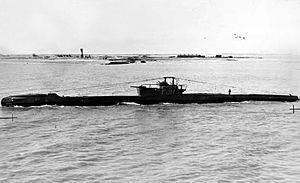Name HMS Tally-Ho Commissioned 12 April 1943 Class and type T-class submarine Construction started 25 March 1941 | Laid down 25 March 1941 Fate Scrapped February 1967 Length 84 m Launched 23 December 1942 | |
 | ||
Motto (first - unofficial) Celeriter in hostem - official Celeriter ad hostem - 'Swiftly among the foe' Builders John Brown & Company, Vickers-Armstrongs | ||
HMS Tally-Ho was a British submarine of the third group of the T class. She was built as P317 by Vickers Armstrong, Barrow, and John Brown & Company, Clydebank, and launched on 23 December 1942. She has been the only ship of the Royal Navy to bear the name.
Contents
Second World War service
While commanded by Captain Leslie W. A. Bennington, Tally-Ho served in the Far East for much of her wartime career, where she sank thirteen small Japanese sailing vessels, a Japanese coaster, the Japanese water carrier Kisogawa Maru, the Japanese army cargo ships Ryuko and Daigen Maru No.6, the Japanese auxiliary submarine chaser Cha 2, and the Japanese auxiliary minelayer Ma 4. She also damaged a small Japanese motor vessel, and laid mines, one of which damaged the Japanese merchant tanker Nichiyoku Maru.
On 11 January 1944, Tally-Ho, then based out of Trincomalee, Ceylon spotted the Japanese light cruiser Kuma and destroyer Uranami on anti-submarine warfare exercises about 10 miles (16 km) northwest of Penang. Tally-Ho fired a seven torpedo salvo at the Japanese cruiser from 1,900 yards (1,700 m), hitting her starboard aft with two torpedoes, and setting the ship on fire. Kuma sank by the stern in the vicinity of 05°26′N 99°52′E.
Tally-Ho sank the German commanded U-boat UIT-23 (formerly the Italian submarine Giuliani), just off the western mouth of Malacca Strait on 14 February 1944.
On the night of 24 February 1944 Tally-Ho was ordered back to the Sembilan Islands, and while zig-zagging on the surface at night charging the batteries, lookouts spotted two wakes ahead. Believing there was a possibility of the two vessels being friendly (both Truculent and Tactician being in the area), Tally-Ho immediately altered course to avoid a collision with the rapidly approaching vessels. On making a challenge with the Aldis lamp the vessels responded by altering course straight towards them and dropping depth charges, leaving no doubt they were unfriendly vessels. At this point the closest ship fired a shell which passed dangerously close over Tally-Ho's conning tower before the attacker passed closely by the submarine and then turned for another attack. During this encounter Tally-Ho had been unable to dive due to the proximity of the attackers and the shallowness of the waters in the straight, in addition, diving would have presented the attacking ships with the opportunity to ram or depth charge the submarine. In the darkness Tally-Ho manoeuvred to a parallel course to the approaching attacker and the enemy vessel passed closely by the submarine, a loud hammering and tearing noise being heard as the ship passed, the vessel being identified as a Hayabusa-class torpedo boat of 600 tons. As the attacker disappeared in the murk Tally-Ho took on a list to port and assumed a marked bow-down attitude. Bennington decided that the batteries would have sufficient charge to risk diving which Tally-Ho then did. Before closing the conning tower hatch, he noticed that the submarine had taken on a 12-degree list. Once submerged, the crew took stock of the damage, and apart from smashed light bulbs and gauge dial glasses, Tally-Ho appeared to be seaworthy, and she remained submerged until 06:30 of 24 February when Bennington brought Tally-Ho to periscope depth and observed his attacker making unusual manoeuvres apparently searching for the submarine on the starboard quarter some 4 miles (6.4 km) off. Tally-Ho remained dived for the following 12 hours before surfacing after dark at 18:25. Upon surfacing it was noticed that the submarine's list had increased to 15 degrees, and it was possible to see the damage to the submarine's port ballast tanks which were all open at the top and beyond further use. With transfer of fuel and water from various tanks and moving of stores and torpedoes, the bow-down attitude was reduced to 4 degrees, and the three-day journey to Trincomalee commenced. This was uneventful apart from encountering a monsoon during the passage of the Bay of Bengal and the possibility of encountering a Japanese submarine close to home. Arriving at Trincomalee harbour on 29 February 1944, Tally-Ho missed her escort and found herself amongst Admiral James Sommerville's battle fleet at exercises. Later, upon examination in dry dock prior to repairs, the extent of the damage to Tally-Ho's port ballast tanks became apparent. The rotating screws of the torpedo boat had run the length of the tanks, chewing large holes in them, phosphor bronze fragments of the attacker's propeller blades being discovered inside. Post-war enquiries learned that their attacker's behaviour after the attack had been due to a combination of Tally-Ho's lowered port bow hydroplane having pierced the torpedo boat's hull, and the vessel's port screw having been shorn of its blades almost down to the hub.
On 29 October 1944, Tally-Ho departed Ceylon carrying an OSS-sponsored three-man Free Thai team bound for Siam. On the way, Tally-Ho tried unsuccessfully to intercept a German submarine. The journey was further delayed by a search for downed Allied airmen near the Straits of Malacca. The Free Thai team was finally landed on Ko Kradan, Trang Province, on 9 November.
Postwar service
Tally-Ho survived World War II and continued in service with the Royal Navy. In 1949, Tally-Ho was deployed to Canada in July, relieving HMS Tudor, where the submarine trained with the Royal Canadian Navy in anti-submarine warfare. Following her service in Canada, Tally-Ho was assigned to the America and West Indies Squadron. In 1953 she took part in the Fleet Review to celebrate the Coronation of Queen Elizabeth II. She was sold to Thos W Ward and scrapped at Briton Ferry, Wales on 10 February 1967.
